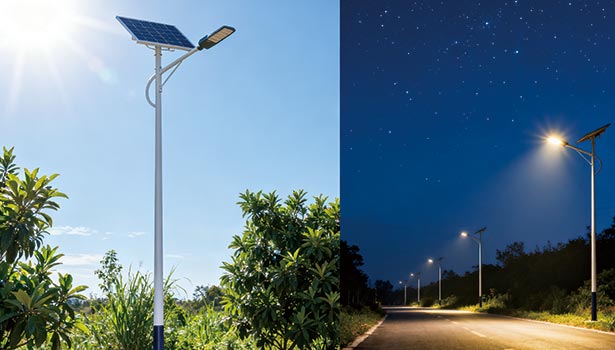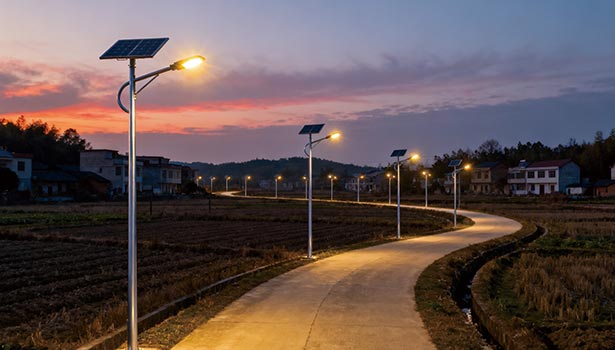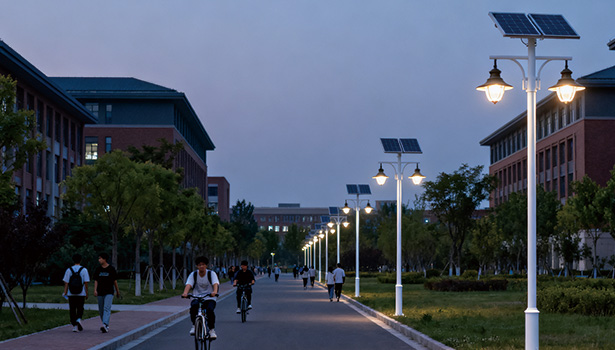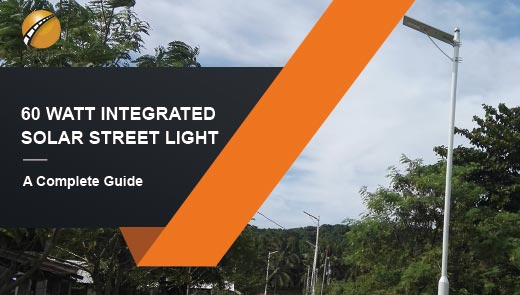How to Set the Lighting Time for Solar Street Lights?
At a time when energy saving and emission reduction has become a global consensus, solar street lights are widely used in roads, communities, parks and other scenarios by virtue of the advantages of zero electricity cost and low maintenance. The reasonable setting of lighting time directly determines the usage effect and energy saving efficiency of solar street lights. In this article, we will start from the working principle, dismantle the lighting time control method in detail, and sort out the core considerations in the adjustment process to help you easily master the solar street light lighting time setting skills.

How Solar Street Lights Work
To accurately set the lighting time, you first need to understand the basic working logic of solar street lights. Its core is based on the photovoltaic effect, through the “power generation - energy storage - power supply” closed-loop process to achieve automatic lighting, can be divided into three key links: daytime power generation and energy storage links, solar street lights on top of the photovoltaic panels in the sunlight will be converted to solar energy into electricity, these electricity will be stored in the battery through the controller's regulation, reserve energy for nighttime lighting. Reserve energy for night lighting.
The controller, as the “brain” of the system, is the core component of lighting time control, with built-in photosensitive elements, timer and other modules, which can monitor the ambient light intensity and battery power in real time, and automatically determine “when to turn on the light and when to turn off the light”.
At night the solar street light will open the automatic lighting link, the controller will trigger the circuit, so that the battery to the LED lights power supply, and early in the morning when the light intensity rises to a certain level, the controller cuts off the lighting circuit, switching back to the charging mode. To put it simply, the lighting time setting of solar street light is to realize automated and intelligent lighting management through the parameter configuration of the controller for “light on trigger condition” and “light off trigger condition”.
Lighting Time Control Methods of Solar Street Lights
Different scenarios have different needs for street lighting, and the corresponding time control methods are also different. The following is a detailed analysis of the four mainstream control methods, including the principle, advantages and applicable scenarios:
Light Sensor Control
Light Sensor Control is the most basic control method, relying on the controller's built-in photosensitive components to monitor the ambient light intensity. When the light intensity decreases to a suitable threshold in the evening, the controller automatically turns on the circuit and the street light is turned on; when the light intensity rises to a certain level in the morning, the controller cuts off the circuit, the street light is turned off and charging is initiated. Its advantage is that no manual intervention, adaptive to seasonal changes and avoid the waste of lights or too late, suitable for suburban roads, parks and trails, rural villages and unmanned remote sections of the road and other scenarios that do not have a fixed lighting time requirements.
Time Control
Time control through the controller preset fixed lighting hours, combined with light control triggered to turn on the lights, to achieve the “light full of hours automatically turn off the lights”. In the evening, when the light intensity reaches the standard, the light control triggers the street light to turn on, and the controller timer starts synchronously, and the light is turned off automatically after reaching the preset duration, regardless of whether the light intensity reaches the standard, and some high-end controllers also support the “multi-hour dimming” to enhance the energy-saving effect.
This method can accurately control the duration, take into account the efficiency of triggering and shutting down and reduce maintenance costs, but it is necessary to adjust the duration according to the season, regularly check the battery power, and at the same time ensure that the preset duration matches the battery capacity.

Remote Control
Remote control is realized by infrared or RF remote control, the core is to temporarily intervene in the lighting status instead of replacing the basic settings of light control / time control, you can manually switch on and off the lights or switch the lighting mode, but you can not modify the preset lighting duration, and the original settings will be restored after restarting the system. It is suitable for nighttime maintenance of municipal roads, community festivals and emergency lighting in stormy weather, etc., which require temporary adjustments.
Smart Control
Smart Control relies on IoT technology to connect street lights to the cloud, real-time monitoring, remote parameter change, adaptive scheduling and data statistics can be realized through mobile APP or PC, which can automatically adjust the parameters according to the season and weather and generate energy consumption reports. Its advantage lies in remote management, data-driven optimization and automatic fault alarm, which is applicable to the scenarios requiring centralized management or refined energy control, such as urban main roads, intelligent parks and highways.
Parameter Reference for Solar Street Light Lighting Time Setting in Different Scenes
Theoretical control methods need to be combined with actual scene landing, the density of pedestrian traffic, night activities and energy demand in different scenes vary greatly, the following common scenes provide specific setup cases and parameter recommendations to help quickly match the optimal program:
Rural Roads and Village Entrances Scenario
Rural roads and village entrances are less crowded, mainly to meet the safety of villagers traveling at night, no fixed activity peaks, and early darkness in winter and late darkness in summer, mostly unattended. It is recommended to control the solar street light mainly by light control and supplemented by basic time control, with the light control threshold set at 5-10lux in the evening and 15-20lux in the morning, and the time control preset at 6-8 hours of illumination (extended to 8 hours in winter and shortened to 6 hours in summer), and 1-2 hours of illumination can be extended or the light control threshold adjusted to 10-15lux in advance of the fall harvesting season by remote control.
Urban Community Road Scene
Urban community road traffic is concentrated in the evening 18:00-22:00, after 22:00, the pedestrian flow suddenly decreases, the need to take into account the peak lighting and energy saving in the valley, and there are festivals, temporary maintenance needs. Recommended light control + multi-time time control with remote control, light control trigger threshold is set to 3-5lux in the evening to turn on the light, time control according to “18:00-22:00 full power, 22:00 - next day 5:00 half power” settings, the next day 5:00 after the light intensity reaches the standard of the solar street light automatically turn off the light, the community to organize activities or nighttime maintenance, can be switched by remote control power. When the community organizes activities or night maintenance, the power can be switched or the lighting can be extended to 6:00 the next day through remote control.
Park and Scenic Area Trail Scene
Park and scenic area trail has many tourists during the day, and at night it is mainly for leisure, which needs to be in line with the natural work and rest and to avoid affecting the neighboring residents, and part of the scenic area has the demand for night tour program. Recommended light control is the main, intelligent control is supplemented, light control threshold is set to 8-12lux in the evening, 15-20lux in the early morning lights off, the intelligent system can be adjusted according to the flow of data on the length of the lighting, the weekend crowd more than 30% more than the extension of 1 hour, the night tour activities through the intelligent APP is set to “timing + dimming” mode, 19:00 - 22:30 power, the night tour activities, the night tour activities, the night tour activities. 19:00-22:30 full power, switch to 30% power after 22:30.
Highway and Bridge Scene
Highways and bridges have traffic flow 24 hours a day, which requires continuous lighting and high light stability, and faults need to be handled in time. Recommended intelligent control, the basic lighting is set to be always on at 30% power throughout the day, and full power is automatically switched at night from 19:00 to 6:00 the next day; when the visibility is lower than 200 meters in cloudy or foggy days, the full-power period will be advanced to 17:00 and delayed to 7:00 the next day, and half-power will be switched to the alarm when the battery power is lower than 20%; after detecting the faults, the system will push the alarm information to the operation and maintenance personnel for timely maintenance. The system will push alarm information to the operation and maintenance personnel for timely maintenance after detecting the failure.

Precautions for Solar Street Light Time Adjustment
Regular System Checks
The premise of lighting time setting is that the system components are normal and need to be checked at least once a month. The photovoltaic panels need to be cleaned of surface dust, leaves and other obstructions to avoid a decline in power generation efficiency resulting in insufficient battery power; batteries need to be checked to see if the wiring is loose and measure the voltage, and replace them when the voltage is too low; the controller needs to make sure that the display screen is normal and that there are no error codes, so that it is easy to quickly troubleshoot the component failures.
Handling Weather Effects
Bad weather will affect the automatic operation of solar street light, continuous rainy or hazy weather light is insufficient, you can switch to “energy-saving mode” or shorten the lighting hours through remote control; heavy rain, sandstorms, need to clean up the surface debris of the photovoltaic panel and the controller in time, to avoid the surface debris of the photovoltaic panel and the controller. After heavy rain or sandstorms, it is necessary to clean the debris on the surface of PV panels and controllers in time, so as to avoid misjudgment of light control thresholds, which may lead to incorrect switching on of lights during daytime.
Use of Remote Control and App
When using the remote control, each time you press the button, you need to wait for a few moments before pressing the button next time, to avoid signal conflicts that cause the controller to crash, and take out the batteries to prevent liquid leakage when you don't use it for a long period of time; after modifying the parameters by using the intelligent APP, you need to confirm the successful synchronization in the “ Device Status”. Device Status" to confirm that the synchronization is successful, to avoid network delays that may cause the modification not to take effect, and to avoid frequent switching of lighting modes within a short period of time in order to reduce the load on the controller.
Cold Weather Precautions
When the temperature is low in winter, the PV panels can be installed with anti-icing coatings or electric heating pads to avoid interruption of power generation due to snow and ice accumulation; the batteries should be of low-temperature-specific types or wrapped with thermal insulation cotton outside the box to prevent capacity shrinkage caused by low temperatures and to ensure that the lighting time settings take effect normally.
The setting of lighting time of solar street light is not a single fixed operation, but needs to be combined with the core working logic of “power generation - energy storage - power supply”, and according to the actual needs of different scenarios, we can flexibly choose the light control, time control, remote control or intelligent control mode, and match the precise parameter configurations. Only by combining scientific control methods with meticulous operation and maintenance management can we give full play to the advantages of solar street lights, provide stable, efficient and environmentally friendly night lighting support for all kinds of scenarios, and help realize the goal of energy saving and emission reduction.




